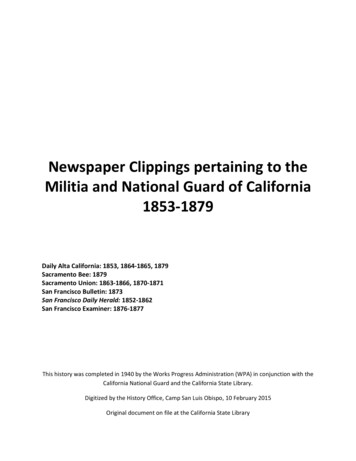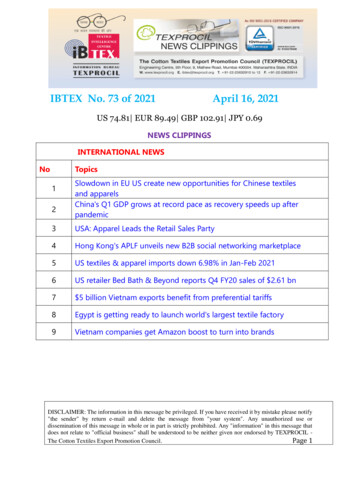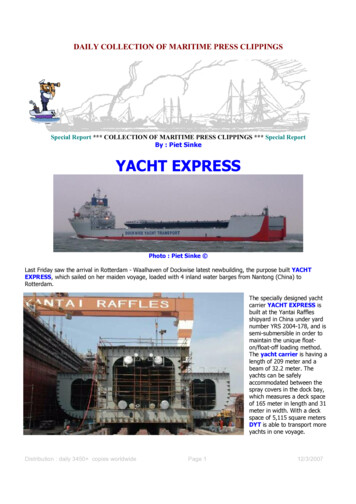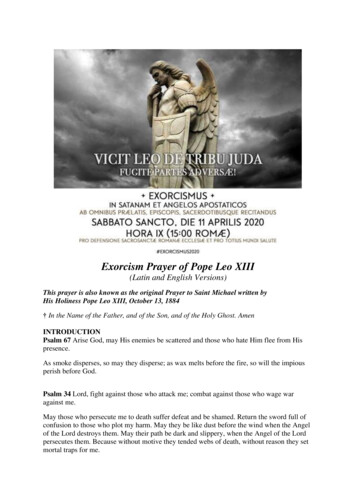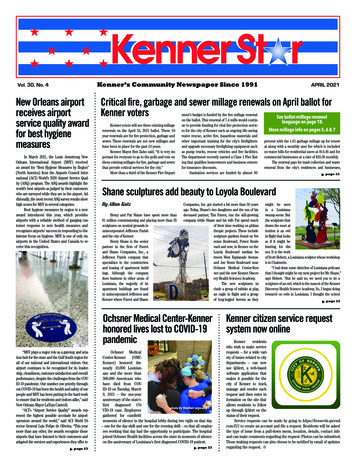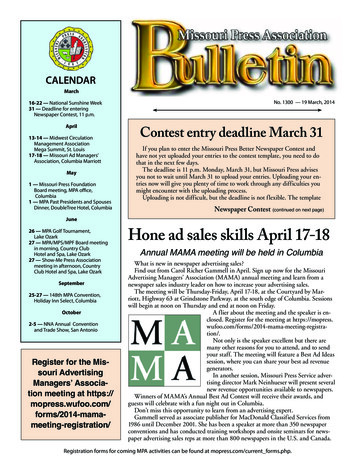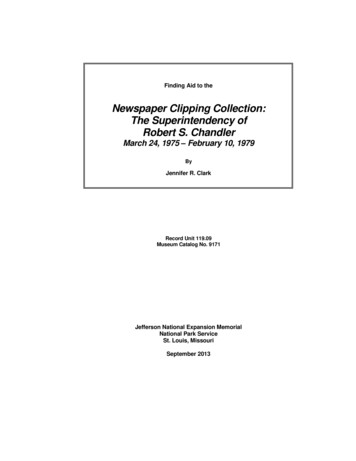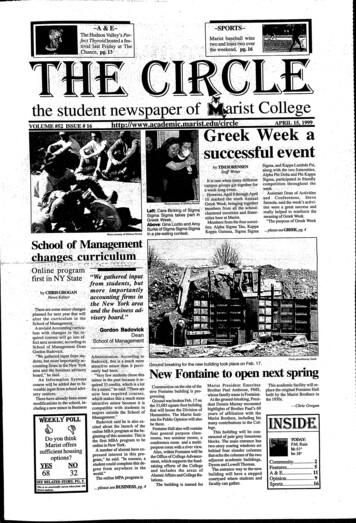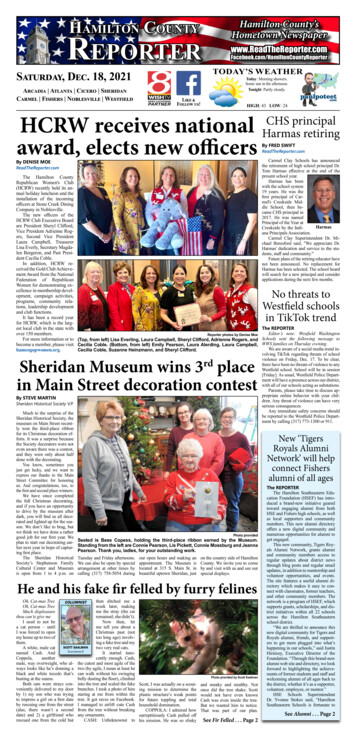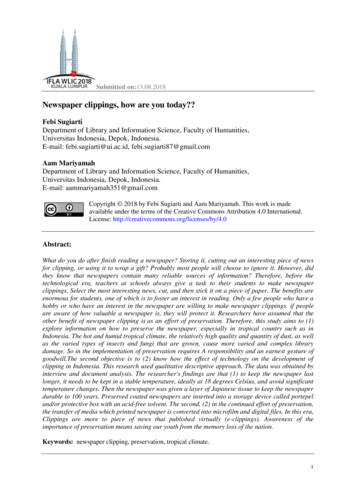
Transcription
Submitted on:13.08.2018Newspaper clippings, how are you today?Febi SugiartiDepartment of Library and Information Science, Faculty of Humanities,Universitas Indonesia, Depok, Indonesia.E-mail: febi.sugiarti@ui.ac.id, febi.sugiarti87@gmail.comAam MariyamahDepartment of Library and Information Science, Faculty of Humanities,Universitas Indonesia, Depok, Indonesia.E-mail: aammariyamah351@gmail.comCopyright 2018 by Febi Sugiarti and Aam Mariyamah. This work is madeavailable under the terms of the Creative Commons Attribution 4.0 International.License: :What do you do after finish reading a newspaper? Storing it, cutting out an interesting piece of newsfor clipping, or using it to wrap a gift? Probably most people will choose to ignore it. However, didthey know that newspapers contain many reliable sources of information? Therefore, before thetechnological era, teachers at schools always give a task to their students to make newspaperclippings. Select the most interesting news, cut, and then stick it on a piece of paper. The benefits areenormous for students, one of which is to foster an interest in reading. Only a few people who have ahobby or who have an interest in the newspaper are willing to make newspaper clippings. if peopleare aware of how valuable a newspaper is, they will protect it. Researchers have assumed that theother benefit of newspaper clipping is as an effort of preservation. Therefore, this study aims to (1)explore information on how to preserve the newspaper, especially in tropical country such as inIndonesia. The hot and humid tropical climate, the relatively high quality and quantity of dust, as wellas the varied types of insects and fungi that are grown, cause more varied and complex librarydamage. So in the implementation of preservation requires A responsibility and an earnest gesture ofgoodwill.The second objective is to (2) know how the effect of technology on the development ofclipping in Indonesia. This research used qualitative descriptive approach. The data was obtained byinterview and document analysis. The researcher's findings are that (1) to keep the newspaper lastlonger, it needs to be kept in a stable temperature, ideally at 18 degrees Celsius, and avoid significanttemperature changes. Then the newspaper was given a layer of Japanese tissue to keep the newspaperdurable to 100 years. Preserved coated newspapers are inserted into a storage device called portepeland/or protective box with an acid-free solvent. The second, (2) in the continued effort of preservation,the transfer of media which printed newspaper is converted into microfilm and digital files. In this era,Clippings are more to piece of news that published virtually (e-clippings). Awareness of theimportance of preservation means saving our youth from the memory loss of the nation.Keywords: newspaper clipping, preservation, tropical climate.1
INTRODUCTIONClipping is often used by teachers as a task to their students. Lingered in our memory, themoment when our junior high school teacher gave a task to look for some articles about anevent in a newspaper. The Olympiad event was chosen at that time to be the theme of newsarticles we had to collect from several newspapers to be made into clippings. However, themaking of clipping is not only done by school students but also college students, researchersand even housewives who collect recipes and then make clippings.Clipping itself is an activity of collecting materials by cutting out articles, pictures or certainparts of newspapers, magazines, or other sources to be pasted into paper or other booksfollowing a certain arrangement, with the aim of documenting. Pieces of articles or images ina clipping usually contain the same theme, for example, recipes, Olympic history, generalelections, politics, history, and so on. The purpose and objective of the clipping itself is tocollect and combine information related to certain themes that originally came from varioussources for personal gain, assignments from teachers, historical memory and so on.Clipping is an important source of information that can be served to users in the library. Inaddition, Somnath Das (2009) mentioned clipping is another form of newspaper preservation,“Press clipping is another form of preservation. It is the most important service in thenewspaper library. The process involves cutting and pasting of important articles and theirorganisation in such a manner that one can easily get access to the desired article”. Thennewspaper clippings can be seen from two sides as preservation of the newspaper as well asinformation repackaging in it.Regarding the making process, it is clear that newspaper clipping form of preservation is thecheapest form for newspaper preservation compared with the process of capsulation andlamination. Even though in storage, it takes a very large space since one type of newspapercan produce dozens of clippings of articles. Then added must keep the low-quality newsprintmaintained and can be used for decades to come. In addition, the geographical conditions ofthe tropical climate make the physical care of newspaper and newspaper clipping is not aneasy matter. Even according to Hart in Walravens (2008), newspaper clipping is vexingbecause of its format, fragility, and housing, and raising a question: if the intellectual contentof clippings can be found by searching the relevant newspapers, why keep the clippings?Nevertheless, the method of gathering, compiling, re-managing information from varioussources such as what is done when making clipping is still the main and fundamental way thatcan still be done until now. So, knowing the progress of the current newspaper clippings onvarious types of information agencies and how the treatment of physical newspapers andnewspaper clippings can be interesting to review.This study aims to explore information about the current clipping conditions of newspapersthrough four types of large information institutions in Indonesia and their relation to thepreservation process of newspapers in a tropical climate, where maintenance of newsprint asthe main source of clipping is not an easy matter, considering the heat conditions and highhumidity level in the tropical country. Besides, how the technology impacts on thedevelopment of newspaper clipping in Indonesia. The study was conducted throughinterviews and observations of the National Library of Indonesia, the National Archives ofIndonesia, Harian Kompas, and CSIS.2
LITERATURE REVIEWWhat is Clipping?According to the American Library Association Glossary of Library Terms (1943: 43); “clippings orclipping file: a collection of clipping from current newspaper and periodicals and other sources,arranged in some definite order in a vertical file. Also called clipping collection.” Clipping is acollection of pieces of newspaper, magazines and other sources that are / will attract attention,arranged with a particular system in an arrangement. Further, the definition of clipping in KamusBesar Bahasa Indonesia (1990) is "Cut out news articles from newspapers, magazines and so on andthen paste it on other paper for documentation".From some definitions above, clippings can defined as anything new, which is and will attractthe public published newspapers, magazines and other sources cut and prepared with aparticular system (Sutarsyah, 2013). Clipping can be very valuable to a person or anorganization because the information contained has gathered a particular event, idea, orknowledge. Clipping is made with a variety of purposes (Lasa, 1990), among others 1) Storeand preserve human intellectual property, 2) disseminate ideas, ideas to others, 3) summarizesome thoughts in a field, 4) cultivate one's creativity, 5) support certain subject matter, 6).Support intellectual activities such as composing papers, papers, thesis and article writing andothers. Therefore the clipping function is very important for those who want to knoweverything new.Clipping can be one of the steps of librarians to provide a package of information services(packaging information) in order to facilitate library users in finding a specific subject.Sturges and Chimsen (1996) in Iwhiwhu (2008: 2) mentioned one of the conditions for repacking of information was that materials must be collected and organized efficiently. Giventhat the phenomenon of information flood (information explotion) that makes users deal withinformation "scattered" in the field, newspaper clippings seem very useful for that. Aslibrarians, librarians should have been able to filter out any information that users really need(Sudarsono, Blasius, 2006).According to Lasa HS (1994), there are at least two types of clippings arrangement:a. Ordnere system, is a system of preparation of articles or news in a composition or folderconsisting of a subject, the material taken from various newspaper titles.b. Evixse system, is a system of compilation of clippings taken from one newspaper titlepublished in a certain period in chronological order. The subject can vary because the timesequence becomes the main thing in this system.The collection of newspaper clippings has many forms. Clipping might be pasted onscrapbook paper or plain paper. According to Yuyun Sutarman, this clipping activity can besaid to be a waste recycling activity. Because the paper used is a waste paper. They got papersfrom various divisions. The head of the clipping division at Centre for Strategic andInternational Studies (CSIS) explained that making good clippings requires creativity. Fromthe start of cutting the news to the attachment of the article, it must not be done carelessly. Itmust pay attention to each sentence to be able to stay connected properly and neatly."Why do you have to be creative?” Because we have to make sure how the newspapers withdifferent characteristics can be neat in the format that we have applied. The right and leftmargins should fit. "Do not be forced in a bent way," Yuyun said. It is also understood afterseeing the condition of rare newspaper clippings in the National Archives of Indonesia3
(ANRI) Many parts are bent because newsprint exceeds the format of white paper,consequently the newspaper has been very fragile it's hard to open because we're afraid it willtear, so to open it we have to be very careful not to break and the edges are not eroded.Pictures and illustrations in newspaper articles need to be included to clarify the information.The thing to remember is to write down the identity of the clipped newspaper, such as thename of the newspaper, the date, month, and year of the newspaper. The glue used for gluingpaper should be glue that does not make the paper wrinkle or curl. Make sure the glue havethe advantage of not using excessive chemicals that are safe for users and environmentallyfriendly. If exposed to hands, do not cause harmful effects on the skin because it will peel offby itself.Overview of the History of Newspapers in IndonesiaIndonesia has a long history of the nation's struggle against the colonials. Newspaper is one ofthe tools of publication as well as propaganda used to achieve independence. The contents ofthe newspaper contain historical information and often used as a clipping material. Thus, theexistence of clippings cannot be separated from the presence of the newspaper itself.Newspapers in Indonesia were originally published by the Dutch colonial. In the mid-18thcentury with the name Bataviasche Nouvelles, published in 1744, in the days of GovernorGeneral Van Imhoff. The first issue of newspapers only contained news about the VOCmerchant ship, official mutations, marriage news, births and deaths. The reader was stilllimited to Dutch citizens. This newspaper was published once a week as many as four pages,all of which were handwritten. This paper then developed rapidly and turned into a newspapercontaining criticism of slavery in Batavia and the behavior of the then VOC ruler (Nurjanah,2014). Then in 1776, "Vendu Nieuws" was published in Jakarta containing news about theauction of home furnishings, which ceased publication since Governor-General Daendels tookover his printing press.Until 1900, Raden Mas Djokomon Tirto Adhi Soerjo, now known as the Father of Indonesiannational journalism, was moved in the year to publish Soenda Berita, then in 1907 publishedthe weekly newspaper "Medan Prijaji" which after going 6 years later became a daily. Thefounder of the Islamic Trade Union is the son of Raden Mas Tumenggung Tirtoredjo. Withthe publication of these indigenous papers, the Indonesian nation for the first time had its ownnewspaper capitalized by the Indonesian people and provided for the Indonesian peoplethemselves. The presence of the Medan Prijaji newspaper became the driving force for thepublication of other newspapers spearheaded by Indonesian struggle figures. However, thenewspaper did not last long. One by one that newspaper was falling. Bankruptcy due to lackof capital and banning by colonial, Dutch and Japanese countries is the cause.Until the independence on 1945, the Indonesian Nation began again to control the printing ofnewspapers. Even after that the organization of Newspaper Issuers (SPS) and the IndonesianJournalists Association (1946) was formed. With the presence of these organizationsIndonesian newspapers have had goals, vision and mission that are sustainable. Althoughundeniably throughout the Indonesian newspaper, the banning often occurred. In theSoekarno Era, 1950-1965, newspapers did experience significant progress but severalnewspapers that were not in line with the goals of guided democracy which he applied wouldbe revoked for publication.4
Entering the New Order era, 1966-1998, where the era of the press was very restrained by thegovernment. At this time according to the government the freedom of the abusive press coulddisrupt the political guidance, therefore the press must be controlled and nurtured. This policyended in the fall of the New Order government, May 1998. Thus, enter the era of freedom ofthe press. This freedom established large media that still survive today, such as Kompas,Tempo, Jawa Pos, and Media Indonesia. These media spread to all parts of Indonesia. Untilthe entry of the Internet, is a new world newspaper. Despite being confronted by newspapersin electronic versions massively, printed newspapers still survive until now.Printed version of rare newspapers (since the Dutch era) in Indonesia can be seen in theNational Library of Indonesia. As the institution responsible for protecting the history of thenation, the National Library has made various policies and efforts in preserving thenewspapers so that it can be enjoyed by the general public now and future generations. Fordeveloping countries such as Indonesia, preservation of library materials still have very littlebudget with insufficient resources, but the National Library continues to strive for continuoussustainability efforts.Preservation Issues in Tropical ClimateThe main purpose of preservation is to ensure that the value of the recorded source ofinformation is sustainable for access to present and future generations. Preservation covers allaspects of preserving library and archive material. These include management, financial,manpower, methods and techniques, and storage policies (Sudarsono, 2006). One of the keypoints in taking a preservation-related policy is to look at local environmental conditions.Basically every library material consists of organic substances that will one day be destroyed.However, by proper handling we can slow down this process of destruction, even nearinginfinity.The tropical climate zone is located on the equator with a position between 23.5 degrees northlatitude to 23.5 degrees south latitude. Areas in tropical climate zones only have two seasons,rain and drought. Occupying about forty percent of the earth's surface, the tropics are home toalmost half the world's population. This area can be considered a hot and humid band aroundthe equator, characterized by slight seasonal changes in temperature. There are variations inclimate in the tropics, but ninety percent of the tropical zones create hot and humid climates,both permanent and seasonal. The remaining ten percent is like a desert, and is characterizedas hot and dry (Baish, 1987a in Teygeler, 2001). The tropical climate allows getting sunlightthroughout the year, even during the rainy season. (Zurnalis, Firzal, and Dharma S, 2017).Areas with a tropical climate in the world can be divided into dry tropical climates and humidtropical climates. Examples of dry tropical climate areas are countries in the Middle East,Mexico and surrounding areas. While some countries in Asia, including Indonesia have ahumid tropical climate, although for some regions in Indonesia, for example some parts of theisland of Nusa Tenggara lead to dry tropical climatic conditions.Some of the characteristics of a humid tropical climate (Lippsmeier, 1994), that affect thepreservation of library materials, include daily and annual temperature differencesfluctuations, absolute humidity is quite high, up to 15 mm during the dry season and in therain season reaches 20 mm, relative humidity ranges from 20-85% depending on the season.High humidity accelerates the growth of algae and moss, organic building materialsdecompose rapidly and many insects. The average storm is 120-140 times in one year.5
Because of the geographical conditions mentioned above, the humid tropical climate hasseveral problems (Lippsmeier, 1994) including unpleasant heat, the need for protectionagainst the sun, rain, insects, and strong winds.The problem or process of deterioration in the tropics is very complex and difficult todetermine the cause whether it is only caused by one cause or whether there are several causesat once. Destructive forces in tropical climates can be classified into three groups namely firstphysical, which includes heat, sunlight, dust and sand; second, chemicals include moisturegases, pollutants and thirdly biologicals namely fungi, bacteria, insects, animals, rodents. Inaddition, ultraviolet radiation and other light energy elements, combined with hightemperatures, produce acceleration of oxidation and hydrolysis.The greatest chemical contamination effect occurs at the saturation point and condensationoccurs. By itself, high moisture content has a large corrosive effect on organic matter(Teygeler, 2001). When constant high relative humidity joins high temperatures and is leftuncontrolled, its deterioration is very rapid. The same deadly combination of heat andmoisture creates an environment suitable for biological agents. The fungus remains inactive inlow relative humidity, but when it reaches seventy percent they multiply. Pseudo insects canoften do irreplaceable damage quickly and secretly.Based on Indonesia's climate conditions, Indonesia has preservation homework that is noteasy. According to Indah Purwani (2012), to deal with large-scale preservation is not possibleto be successful and can be developed without a priority scale that leads to collection and userinterests. According to him, so far the National Library of Indonesia adopted what hasbecome the standard set by the International Federation Library Association (IFLA), Principlefor the Preservation and Conservation of Library Materials.Newspaper is one type of library collection included in the priority scale of preservation.Because in general, the quality of the paper is low and quickly damaged, however, theinformation is needed as an important reference material that is often sought by the public andresearchers. Parry in Feather: 77 in Indah Purwani (2012) says that "The preservation of thepresent two related physical problem newspapers: there are huge numbers of them, and theyare generally printed on very poor paper"METHODOLOGYThis article is designed using a qualitative approach with desc
newspaper clippings can be seen from two sides as preservation of the newspaper as well as information repackaging in it. Regarding the making process, it is clear that newspaper clipping form of preservation i
